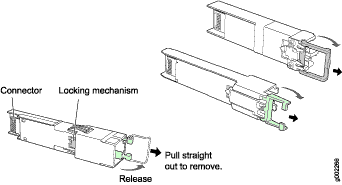Maintaining MX240 SFP and XFP Transceivers
Replacing an SFP or XFP Transceiver from an MX240 DPC, MPC, MIC, or PIC
Small form-factor pluggable transceivers (SFPs) and XFPs are optical transceivers that are installed in a DPC, MPC, MIC, or PIC. SFPs and XFPs are hot-insertable and hot-removable.
- Removing an SFP or XFP Transceiver from an MX240 DPC, MPC, MIC, or PIC
- Installing an SFP or XFP Transceiver into an MX240 DPC, MPC, MIC, or PIC
Removing an SFP or XFP Transceiver from an MX240 DPC, MPC, MIC, or PIC
Removing an SFP or XFP does not interrupt DPC, MPC, MIC, or PIC functioning, but the removed SFP or XFP no longer receives or transmits data.
To remove an SFP or XFP transceiver (see Figure 1):
CAUTION:
After removing a transceiver from the chassis, wait at least 30 seconds before reinserting it or inserting a transceiver into a different slot.
See Also
Installing an SFP or XFP Transceiver into an MX240 DPC, MPC, MIC, or PIC
To install an SFP or XFP:

